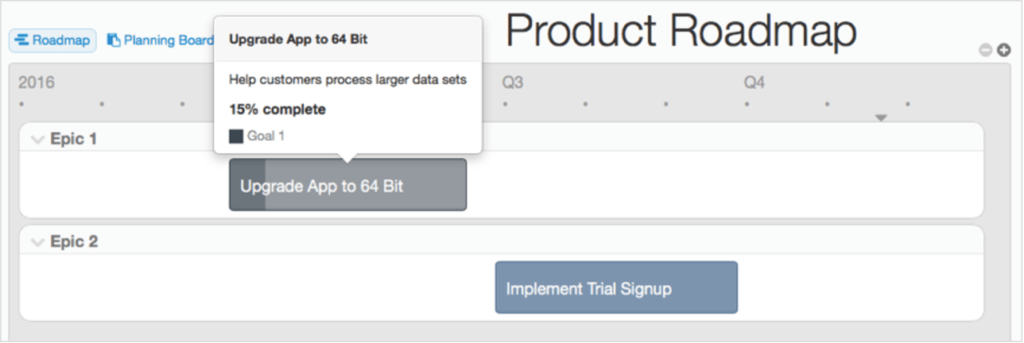Let me open with a provocative statement. If anyone in your company who’s involved in bringing your product to market (a sales rep, a developer, an executive stakeholder) doesn’t know the strategic reason you’re doing something and doesn’t know where to find that information, then you’re neglecting an important part of your job as a product manager.
This isn’t to suggest that you don’t have a strategic basis for the decisions you’re making. The problem most product managers face isn’t necessarily that they’re lacking strategic thinking — it’s that they’re lacking an effective mechanism to collaborate with the right people, at the right time, to develop and update that strategy, and to communicate it whenever necessary to the people who need to know it.
The product roadmap is mission-critical to a product’s success because it’s the primary tool you’ll use to share your goals with the teams who need to know the strategic thinking behind the tasks they’ve been given. Everyone involved in a project can make better-informed decisions when they know the reason they’re doing something in the way they’ve been asked to do it. By contrast, when people try to build a product, or sell it, or demo it, or develop a promotional campaign for it without understanding the strategic thinking behind it, the odds of those teams creating a cohesive, successful product fall off sharply.
Tweet This:
“The roadmap is mission-critical to a product’s success because it communicates your strategy.”
But just like an invention that never gets beyond the brainstorming stage or a novel manuscript that sits forever in an author’s desk drawer, a product roadmap can’t fulfill its vital role of communicating strategy if it’s not shared across the organization.
What Roadmap Collaboration Means (and Doesn’t Mean)
It’s worth pointing out that roadmap collaboration does not mean publishing a roadmap with “anyone can edit” privileges. As the product manager, you are the sole owner of that document, and that’s the only way to ensure your roadmap remains a single source of truth for product planning and strategy across your company.
But that does not mean you should build or maintain your roadmap alone. Broadly speaking, here are the three ways you’ll want to make your roadmap a collaborative undertaking.
1. Collaborate in developing the strategy.
You’ll need to collaborate with all relevant stakeholders and sources of information in developing your product’s strategy. That means building the roadmap itself will be a collaborative effort, in which you’ll seek out input from sources such as:
- Your sales reps, to tell you what functionality their customers are telling them are most important
- Your sales engineers, to tell you which aspects of their product demos are generating positive feedback from prospects, and which aren’t
- Your developers
- Your customers and prospects
- Your executives
- Your customer support team
This list could go on, of course. The point is, roadmap collaboration should begin at the earliest stages of your strategic planning and roadmap development.
2. Share the roadmap — to ensure everyone is on the same page.
When you’ve completed a working version of your product roadmap (remember, the roadmap is never “finished,” but rather always evolving), you’ll want to share it with the various teams who will be involved in bringing it to market.
The format this communication takes will vary from company to company, but you will want to hold meetings to present your product roadmap with such groups as your executives, sales, marketing, and perhaps even your customers.
These initial meetings are important to generate enthusiasm and motivation for your product. But they’re also vital for a more practical reason: They represent your opportunity to communicate your product’s strategic goals and to get a pulse check from everyone involved to make sure they understand the thinking behind the decisions you’ve made. It’s important to take this pulse check, to make sure everyone gets it, right at the beginning of your product’s development.
Note: From this point forward in your product’s journey to market, you’ll want to make your roadmap available to all stakeholders, so they can view it anytime. For this reason, if you’ve created your product roadmap as a static document using an application like Excel® or PowerPoint® (definitely not the best tools for product roadmaps, by the way), you should publish the roadmap to a company wiki, an intranet site or a shared network drive.
Ideally, though, you’ll instead create your roadmap using web-based product roadmap software. This will allow your teams to view your roadmap online, from anywhere, and easily drill down to the level of detail they need to review.
3. Update everyone as the roadmap changes, or at a regular cadence to make sure you’re all still on track.
Finally, your roadmap collaboration should take the form of regular communications with all relevant parties throughout your product’s development, at whatever cadence makes sense for your company.
You might want to think of this as the journalism component of your role as a product manager. Part of your job is to regularly communicate your product’s progress, as well as any updates to your roadmap or new information that could affect product strategy, to the relevant members of your team.
So you’ll want to develop an ongoing communication strategy that gives you a chance to regularly meet with the various groups working on your product.
An example of an ongoing communication plan might look like this:
- Executive roadmap review (Quarterly)
- Sales and marketing roadmap review (Monthly)
- Development roadmap review (Monthly)
- Customer roadmap update/Q&A (Monthly)
- Email updates to all relevant parties when roadmap changes (As Needed)
This last point is critical. Whatever plan you establish for regular communication with your teams, that plan should also include a mechanism to send proactive notices anytime something significant on the roadmap changes — such as a major feature getting pushed out, or a restructuring of your strategic goals for the quarter.
This is one more reason that using native roadmap software is such a smart decision. With the right software, users can select to get notified whenever the roadmap is updated. This eliminates the risk, if you’re using a spreadsheet or presentation software, that you’ll make an important update to your roadmap and then forget to send an email out notifying your team to review it.
Your Roadmap Should Always Contain Clearly Written Strategy for Each Initiative
How exactly can you include strategic thinking in your roadmap?
Going back to our journalism metaphor, you can think of any epic, story, or feature on your roadmap as a headline: “Upgrade App to 64 Bit,” for example. Then you can create a subhead below that item articulating the strategic reasoning — the why — supporting it. As you can see from the sample below, created using our SaaS roadmap tool, a simple one-line subhead — “Help customers process larger data sets” — clearly explains why you’d prioritize beefing up your app to the 64-bit standard.

Tweet This:
“Engineers should understand the ‘why’ behind their work and how it relates back to delivering customer value.”
With a simple strategic explanation like this one across your roadmap, your engineers will understand the “why” behind their work and how it relates back to delivering customer value.
Drafting Your Product Roadmap is Only the First Step to Roadmap Collaboration
One of the most frustrating comments a product manager can hear is, “We don’t seem to have a strategy for this product.” Of course, chances are the product manager does have a well-thought-out product strategy, and she has probably discussed it in her most recent quarterly meeting with her executives. Moreover, the strategy is likely written clearly across the product roadmap.
What that commenter is really saying is, “I haven’t heard what the strategy is.” This is why drafting your roadmap isn’t the final step in communicating your product’s strategy — it’s the first step.
Tell us about your experiences with roadmap collaboration. What works for you? What should product managers avoid? Please share your thoughts in the comments section below.


